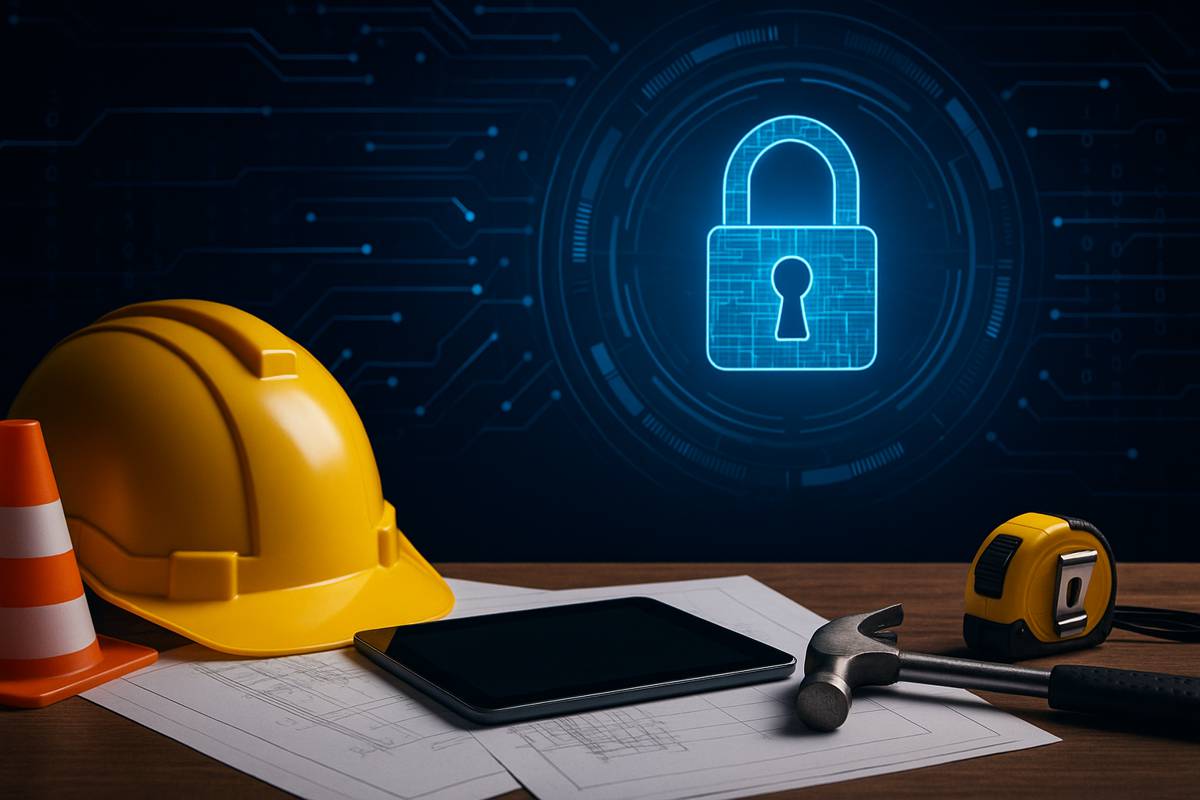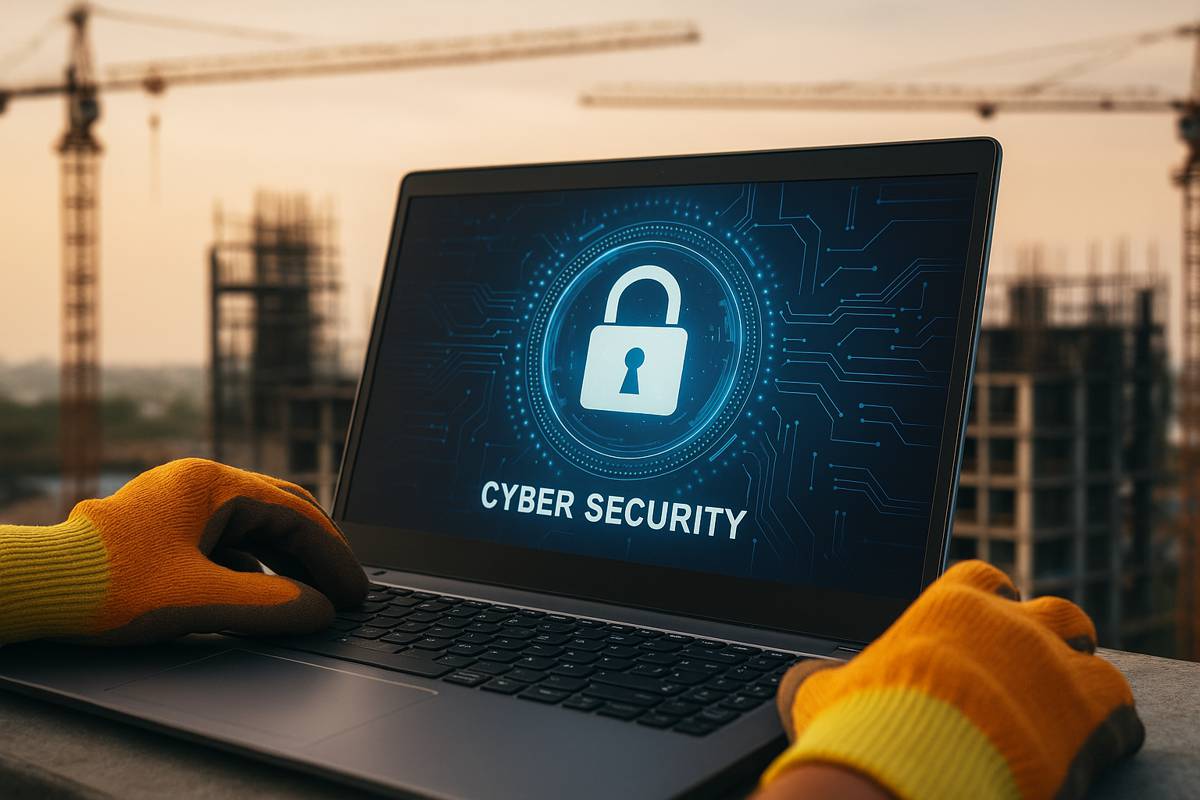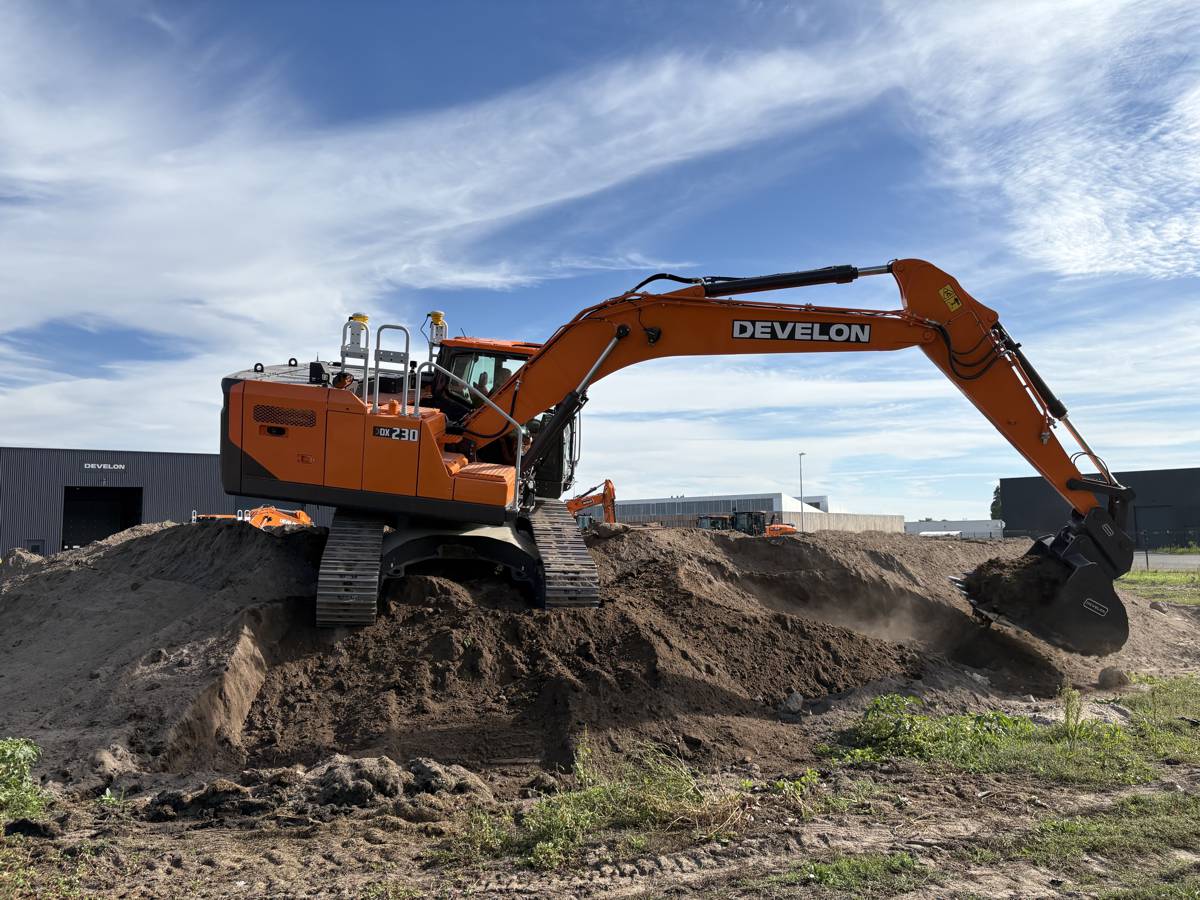Innovation Under Pressure to Protect Construction’s Digital Supply Chain
Digital collaboration has become the backbone of modern construction projects. Design plans, 3D BIM models, procurement orders, and even instant payments now flow through complex supply chains spanning consultants, contractors, suppliers and clients. As the industry embraces these digital tools to boost efficiency and transparency, it also faces unprecedented construction cybersecurity pressures.
With every new software platform and cloud exchange, there’s a growing need to protect sensitive data, from proprietary designs to contract details, against breaches and ransomware. In an era where innovation is under pressure, ensuring data security across the construction supply chain has become as critical as laying a firm foundation.

Digital Collaboration Across a Complex Supply Chain
Walk onto a major construction site today and you’ll find tablets replacing paper plans, drone surveys feeding live models, and cloud platforms linking architects with engineers and suppliers in real-time. Building Information Modeling (BIM) coordination means that architects’ 3D models are shared with contractors, subcontractors, and facility managers, everyone builds off the same digital blueprint. Procurement has gone online too: contractors use e-tendering portals to source materials globally, while payment systems handle multimillion-pound transactions electronically.
This web of digital connectivity knits together dozens of firms on a single project, creating what one might call an “Internet of Construction Things.”
This interconnectedness drives efficiency and transparency: errors are caught earlier, deliveries are tracked precisely, and all stakeholders see a unified picture of progress. However, it also means that one weak link can expose the entire chain. A single compromised subcontractor’s login or a malware-infected supplier’s system can become the entry point for attackers to reach an otherwise secure project environment.
The more parties and devices plugged into a project’s network, the larger the digital “attack surface” for hackers to probe. As Avery Dean, a cybersecurity consultant at Basalt Cyber, observes: “Every sensor and digital twin is a potential entry point for attackers. We must bake security in from the ground up.” In other words, the construction industry’s drive to connect and innovate must be matched by an equally vigorous effort to secure each connection.

A Surge in Supply-Chain Cyber Threats
Across all industries, supply-chain and construction cybersecurity attacks are on the rise, and construction is increasingly in the crosshairs. Nearly 40% of cyberattacks are now thought to originate in the extended supply chain. Attackers have learned that it’s often easier to breach a smaller vendor or software provider and use that as a pivot into larger targets. In construction, this might mean infiltrating a design consultant’s IT system or a cloud-based project management tool, then leaping into the prime contractor’s network or even into smart building systems.
The infamous SolarWinds incident in 2020 showed how malicious code slipped into a routine software update could cascade to thousands of victims, a stark reminder that trust in third-party software can be exploited on a massive scale. While that attack hit government and tech sectors, the lesson resonates loudly in construction, where specialised software (for BIM, scheduling, cost control, etc.) is ubiquitous and often developed by third parties.
The construction sector is now among the top three most-attacked industries in 2025. Why? Its combination of high-value projects, tight schedules, and a traditionally lower focus on cybersecurity makes it attractive to cybercriminals. A report by Rapid7 highlights that construction’s “complex, interconnected supply chains” provide a gateway for attackers. Each subcontractor or supplier with network access, each cloud collaboration, is a potential avenue for a breach. At the same time, many firms still run legacy IT systems and have limited cyber defences, making them comparatively soft targets.
The rush to digitise, adopting IoT sensors on sites, live drone feeds, and AI-driven analytics, has expanded the attack surface faster than many companies have managed to secure it. And the data at stake is lucrative: beyond personal information, hackers covet proprietary blueprints, bid estimates, client contracts and intellectual property that construction firms hold. Stealing a confidential design or a bidder’s pricing strategy could yield a treasure trove for industrial espionage or extortion.

Lessons From Cyber Incidents in Construction
Real-world cases illustrate how devastating supply-chain cyber incidents can be for construction and infrastructure projects. Perhaps the most eye-opening was the NotPetya ransomware outbreak in 2017, which didn’t specifically target construction but ensnared a major player in its collateral damage.
Saint-Gobain, the French construction materials giant, was hit by NotPetya and had to halt operations globally. The malware spread through trusted software updates and shut down the company’s IT systems, delaying shipments of critical materials and racking up over $384 million in losses. Projects around the world suddenly faced material shortages and delays because one supplier’s network was crippled. It was a painful demonstration that a cyber attack on a supply-chain partner, even a few steps removed, can ripple down to every construction site relying on that partner’s products.
Another incident exposed the human side of supply-chain risk: In 2020, Turner Construction, one of the largest contractors in the US, fell victim to a targeted business email compromise scam. Fraudsters impersonated a trusted vendor by email and tricked Turner staff into wiring large payments to criminal-controlled accounts. The sophistication of the ruse (complete with fake invoices and familiar-sounding sender addresses) showed how easily a communication channel between contractor and supplier could be subverted. While Turner, due to its size, absorbed the financial hit, a smaller firm might have been ruined, and indeed many have suffered unrecoverable losses from such scams. This case underlined that securing the supply chain isn’t just about firewalls and antivirus, but also about vigilance in administrative and financial processes.
Smaller contractors are by no means safe either. In recent years, regional firms like Skender (a builder in Chicago) and SPANN Roofing (a family-run contractor in South Carolina) were both crippled by ransomware attacks that locked up project files and stole sensitive data. The criminals behind these breaches not only encrypted the companies’ data but also threatened to leak client information and contracts, a double extortion tactic aimed at pressuring payment.
Such construction cybersecurity incidents underscore that cyber threats in construction spare no one, from global conglomerates to local builders. And when an attack strikes mid-project, the outcome is invariably costly: work stops, deadlines slip, contract penalties loom, and reputations take a hit.
“In construction, delays cost money, and cyberattacks cause delays,” noted one industry analysis, bluntly capturing the stakes. “Whether it’s ransomware locking up blueprints or payment fraud draining your project funds, cybersecurity must be part of your business plan.” In short, the sector is learning that digital risk management is now as essential as managing cost, schedule, or safety on site.

Vendor Management and Zero Trust
Given these sobering lessons, construction firms are rethinking how they manage relationships with vendors and partners. The old approach of trusting any company that has signed a contract or any device plugged into the network is giving way to stricter controls. Many are turning to the principles of Zero Trust security, which operates on the mantra “never trust, always verify.”
In practice, zero trust means that even if a subcontractor has network access, they are not automatically trusted, their access is limited to only what is necessary, and their identity and activity are continuously authenticated and monitored. For example, an electrical subcontractor’s login might only permit access to the specific BIM files or procurement portal sections relevant to their package, and nowhere else. If that subcontractor’s credentials are stolen, the attackers would find their reach severely curtailed.
Crucially, zero trust also entails segmenting networks so that a breach in one area cannot easily spread. On a project’s IT infrastructure, the site CCTV cameras, smart HVAC systems, and project management servers should ideally sit in separate, compartmentalised zones. That way, if a hacker compromises an IoT sensor or a smart crane’s telematics (perhaps via a default password or outdated firmware), they cannot leap into the more sensitive financial or design systems. As one Basalt Cyber expert put it, securing modern construction tech involves “encrypted data exchange and rigorous network segmentation [to] ensure that the model you’re building on hasn’t been silently compromised.”
Vendor management is equally vital. Every contractor now needs to ask tough questions of their suppliers and consultants: What cybersecurity measures do they have in place? Do they regularly patch their software and train their staff? Have they ever suffered a breach, and if so, how did they respond?
Leading firms are beginning to incorporate cybersecurity clauses into their contracts, for instance, requiring subcontractors to adhere to certain standards (such as ISO/IEC 27001 for information security or achieving a Cyber Essentials certification) and to notify the main contractor immediately in the event of any cyber incident.
Some project owners, particularly in government infrastructure contracts, insist that bidders demonstrate robust cyber programs or even carry cyber insurance as part of qualifying to bid.
This is a cultural shift for an industry where partnerships are often long-standing and based on personal trust built over years. But in the digital age, an honest mistake by a trusted partner can cause havoc. “Despite having strong internal security measures, organizations can still be vulnerable if their partners are compromised,” notes Jason Krauss, a cyber risk specialist at insurance broker WTW. In other words, Company A might have every door locked, but if Company B holds a key (access credentials) and loses it to an intruder, Company A suffers all the same.
To counter this, some contractors now conduct periodic third-party cybersecurity audits, assessing the defences of their key vendors much like they would audit for quality or safety. Others are exploring shared security dashboards, where critical partners agree to continuous monitoring of each other’s connections for anomalies, a form of collective defence within project ecosystems.

Cyber Hygiene on Site and in the Office
Technology alone will not solve the problem; people and basic cyber hygiene are at the heart of defence. Construction companies, large and small, are realising that improving everyday digital practices can thwart a great many attacks. A surprisingly common scenario in breaches is an employee inadvertently clicking a malicious email link or using a weak password that gets guessed.
Thus, many firms are instituting regular cybersecurity awareness training, toolbox talks for cyber, so to speak, teaching staff how to spot phishing emails, suspicious texts, or strange phone requests. Site managers and project administrators are being trained to verify any unexpected request to change a supplier’s bank account details, for example, through a direct phone call, as a safeguard against email fraud.
Basic steps can yield big gains. Multi-factor authentication (MFA) is now a must-do: requiring a second step (like a code on one’s phone) for logging into email, procurement systems, or remote desktop apps can stop an attacker who has stolen a password in its tracks. Likewise, keeping software and firmware updated on everything from office PCs to crane sensors is vital, many attacks, including ransomware, exploit known vulnerabilities that a simple patch would fix.
Just as machinery on site gets regular maintenance, digital systems need their “patch and repair” routines. Companies are also urged to back up critical data regularly and store backups offline or in secure cloud vaults. In the event of a ransomware attack that encrypts project files, an up-to-date backup can mean the difference between a minor hiccup and a complete shutdown of work for weeks.
Construction sites present unique challenges: devices move between field and office, and many users share files on the go. Ensuring secure configurations on mobile devices, using VPNs or other encrypted channels when connecting remotely, and enforcing role-based access (so that, for instance, a site foreman’s account can’t suddenly access the entire company HR database) all form part of good cyber hygiene.
As one industry veteran quipped, “I don’t have to run faster than the tiger; I just have to run faster than you.” In cybersecurity terms, if a contractor is diligent with basic protections, most opportunistic hackers will move on to find an easier victim. In a supply chain context, raising the baseline cyber hygiene of every participant, contractors, designers, suppliers, even equipment manufacturers, will significantly reduce the overall risk of a breach in the project network.
Basalt Cyber, a firm specialising in securing critical infrastructure projects, often advises that contractors treat cyber hygiene with the same seriousness as physical safety protocols. That means instilling a culture of security: just as wearing hard hats and high-vis vests is second nature on site, practices like strong passwords, regular software updates, and scepticism towards unsolicited emails should become second nature in the back office.
“We must move from reactive security (patching after the fact) to a proactive stance: continuous monitoring, threat hunting, and secure-by-design devices,” urges Basalt’s Avery Dean. In practical terms, proactive measures include actively scanning networks for unusual activity, simulating cyber drills (much like emergency response drills) so that teams know how to respond to a breach, and building security features into new tech deployments from the outset rather than as an afterthought.
Key cyber hygiene practices for construction firms and their partners might include:
- Regular training and phishing simulations: Keep all staff alert to common attack tactics.
- Multi-factor authentication everywhere: Protect email, VPNs, and cloud apps with an extra login step to stop attackers using stolen passwords.
- Frequent software updates and patching: Ensure all project management tools, BIM software, and field devices have the latest security patches to close known holes.
- Least-privilege access controls: Give each user and vendor account the minimum access needed for their role, limiting the damage if an account is misused.
- Backups and incident response plans: Back up project data daily, and have a clear plan so that if a breach occurs, everyone knows how to isolate the issue and restore systems quickly.
By reinforcing these fundamentals, construction teams greatly improve their odds of fending off attacks or containing damage, even as sophisticated threats continue to evolve.

Transparency, Trust and Compliance
One of the great benefits of digital collaboration is improved transparency, project owners can see issues in real time, contractors can coordinate seamlessly with subs, and regulators can be given access to documentation as needed. But how do you maintain this openness while also keeping tight security? It’s a delicate balance, often requiring smart data governance.
Many firms are adopting data classification policies, deciding which information is highly sensitive (and should be tightly restricted) versus what can be broadly shared. Detailed engineering drawings for a nuclear facility, for instance, might be compartmentalised on a need-to-know basis, whereas a general progress report might be accessible to all stakeholders. Modern collaboration platforms allow for setting such permissions, and project managers must actively curate who has access to what.
When it comes to regulatory compliance, construction firms also have to be mindful of data protection laws and industry standards. In the UK and Europe, GDPR (General Data Protection Regulation) means that any breach involving personal data, say, employee payroll details or private addresses in a contractor’s database, can lead to heavy fines and legal consequences if not handled properly.
Ensuring compliance adds another layer of pressure: it’s not just about keeping hackers out, but also about being able to detect, report, and mitigate incidents in accordance with the law. Regulatory audits may require evidence that supply-chain partners are also following good practices, pushing firms to extend their security diligence outward. On large infrastructure projects, government clients might enforce specific cybersecurity frameworks (the UK’s NCSC, for example, has published tailored cyber guidelines for construction companies), and failing to meet these can disqualify firms from bids.
There’s also the matter of client trust. Construction projects often involve confidential information beyond just drawings, think of a high-profile corporate headquarters build or a sensitive government facility. Clients need reassurance that their project data (including any intellectual property or strategic plans) won’t be leaked or tampered with.
Demonstrating strong cybersecurity is increasingly part of winning that trust. Some contractors now highlight their cyber credentials in bids: citing standards they comply with, secure IT architecture, or even hiring dedicated cybersecurity professionals for major projects. In one sense, robust data protection measures are becoming a selling point and a mark of quality, much as stellar safety records have long been.
At the same time, maintaining collaborative trust requires transparency when incidents do happen. Just as safety culture encourages reporting and learning from every accident or near-miss, a mature cyber culture will have partners openly communicate about breaches or weaknesses. This might mean a supplier promptly informing a contractor that their email was hacked so that everyone can be on alert for fraudulent messages.
It takes a degree of honesty and cooperation that might feel uncomfortable, but it ultimately strengthens the resilience of the whole supply chain. Project alliances that foster this openness, where all parties agree that “we’re in this together” regarding cybersecurity, are likely to fare better against cunning adversaries than those where everyone fends for themselves.

Building Resilience into Innovation
Construction is sometimes seen as a traditional industry, but it’s clearly undergoing a digital revolution. From smart motorways to automated construction equipment, innovation is reshaping how we build. However, if that innovation is to deliver on its promise under pressure, it must rest on secure foundations. A data breach or ransomware attack can wipe out the gains of digitisation in an instant, bringing work to a halt and eroding confidence.
Conversely, by investing in cybersecurity and weaving it into the fabric of project management, firms can turn data protection into a competitive advantage. A secure supply chain is a reliable supply chain, one that keeps projects on track even in the face of cyber turbulence.
The industry is gradually acknowledging this reality. Cybersecurity is moving from the IT backroom to the executive boardroom and the site office. Leading contractors now talk about cyber risk in the same breath as they discuss safety risks or financial risks. Collaborative initiatives are emerging, such as information-sharing groups where construction companies and infrastructure operators share threat intelligence about attacks they’ve seen (much as airlines share safety alerts).
Regulators and industry bodies are also raising the bar, encouraging standards like the NIST Cybersecurity Framework or sector-specific guidelines, so that every participant from architects to material suppliers steps up their cyber game.
Ultimately, protecting data in the construction supply chain isn’t about stifling innovation, it’s about enabling innovation to thrive safely. When everyone in a project ecosystem knows that strong security measures are in place, digital tools can be used with confidence. Teams can embrace cloud BIM coordination or remote IoT monitoring without constant fear of “what if someone hacks this?”
The payoff is huge: projects delivered on time without digital disruptions, trusted relationships between owners and contractors, and infrastructure that isn’t secretly compromised by unseen threats. As one cybersecurity consultant remarked, it’s akin to building a fortress while also building a project, you construct not just the physical edifice, but a digital shield around it.
In the end, the construction firms that will lead in the coming years are those that marry innovation with vigilance. They will treat cybersecurity not as a cost or annoyance, but as an integral part of doing business in a connected world. By fortifying their digital supply chains, these firms ensure that progress on site isn’t derailed by a ransomware note in someone’s inbox. Instead, they can focus on the real pressure that drives innovation, delivering better, greener, more ambitious projects, knowing that their data and systems are protected.
In construction’s new digital era, the best innovators will indeed be the best defenders of their information.




















